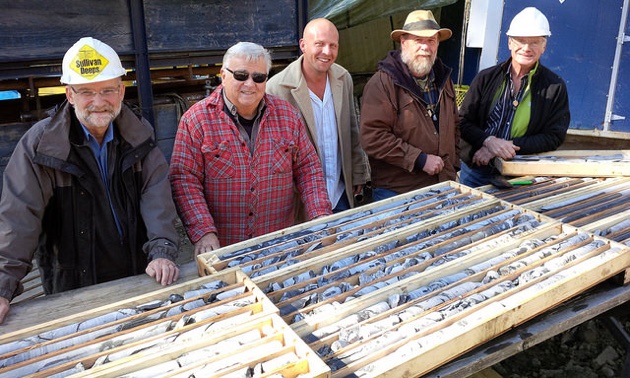Santa Fe Metals exploring near historic Sullivan mine
Santa Fe Metals exploring near the Sullivan mine

L to R: Brian Jones (Excel Geophysics and gravity expert), Brian Kostiuk (Sully vendor), Mike Kennedy (Sully vendor), Craig Kennedy (local prospector), Paul Ransom (Sully project manager) — Photo courtesy Santa Fe Metals
Vancouver-based Santa Fe Metals Corporation recently signed an agreement with Philippine Metals Inc. to sell 100 per cent of Santa Fe's interest in the Cuatro Cienegas property in Mexico to Philippine Metals. Philippine Metals agreed to pay a total of $150,000 to Santa Fe to acquire all of the issued and outstanding shares of Compania Minera Coronado S.A. de C.V. The latter company holds Santa Fe's 100-per cent interest in the Cuatro Cienegas project.
Proceeds from the sale of the Mexican property will enable Santa Fe to focus its efforts entirely on its large-scale zinc-lead-silver targets in southeastern British Columbia. The projects in question are Iron Range, with multiple sedimentary exhalative (SEDEX) and iron oxide copper gold (IOCG) precious metals target, and the Sully project, a Sullivan Mine-scale SEDEX target that was advanced in 2014 by geophysical work and exploration drilling.
Santa Fe has an exclusive option to earn a 60-per cent interest in the 69,000-hectare Iron Range property, located 15 kilometres northeast of Creston. It overlies the same stratigraphy that hosts the large Sullivan Mine SEDEX deposit in nearby Kimberley. The Iron Range covers the Iron Mountain Fault Zone, a deep-seated regional fault containing significant iron oxide and iron sulphide mineralization. The property was staked for its iron potential in 1897, but present-day owner Eagle Plains Resources Ltd. staked it in 1999 when the overlying Crown grants expired. Since it acquired the property, Eagle Plains has focused on exploring for both SEDEX silver-lead-zinc and iron-oxide-copper-gold mineralization.
The Sully Project is located 30 kilometres east of the Sullivan Mine. In early 2014, Santa Fe's project team defined twin parallel vertical masses at Sully, the East and West targets. Santa Fe president and CEO Scott Broughton said each of the targets has geophysical gravity anomalies with over 2,000 metres of apparent north-south strike and are estimated to come within 500 metres of the surface. “Airborne magnetic anomalies validate the dual targets, and surface zinc and lead soil geochemical anomalies above the targets may indicate leakage from a mineralized source at depth,” Broughton said.

Farren Billey (FB Drilling contractor from Cranbrook), Ian Smith (SFM chair), Paul Ransom (Sully project manager) — Photo courtesy Santa Fe Metals
In 2014 Santa Fe started exploration drilling work at the East target. Broughton said the drilling intersected strata that are about the same geological time as the Sullivan Mine. And the use of oriented core provided definition of structural aspects of the geological setting for the first time. “Drilling has moved progressively closer to intersecting the centroid (geometric centre) of the gravity mass that appears to coincide with the projected position of (strata of the same geological time as the Sullivan deposit),” Broughton said. “The drill hole most recently completed is estimated to have passed within 100 metres of the East mass.”
The exploration program for 2015 and 2016 includes additional detailed gravity measurements, followed by continued drill testing of the East and West targets. Broughton said Santa Fe management believes the successful identification of Sullivan-size targets at the Sully project indicates that modern and efficient exploration techniques in the basin can deliver “exciting results.”
Discovered in 1892, the Sullivan Mine is one of the world's largest zinc-lead-silver SEDEX deposits. Over its nearly 100-year lifetime, the mine produced approximately 164 million tonnes of ore that yielded almost 36 billion pounds of zinc and lead, 300 million ounces of silver, and smaller amounts of tin, gold and other metals. Altogether, the metals had a value of more than C$47billion. Broughton said the sedimentary basin that hosts the Sullivan SEDEX deposit is prospective for similar deposits. “But a review of the region's history shows it has had only sporadic and localized drilling efforts,” he said. “Although broad-scale reconnaissance mapping and geophysics have been completed in some places, large areas of the basin remain under-explored and untested.”
Broughton said his company sold its property in Mexico in order to raise financing for its Iron Range and Sully projects. “Funding for junior exploration companies has been very difficult to attain over the past year, and this has slowed the company's exploration progress during that time,” he said. “However, the company is pleased to report new interest is being expressed by offshore mining investment houses that seek early-stage zinc and other base metal opportunities in prolific metals mining regions in British Columbia and Canada.” Broughton said Santa Fe is actively marketing opportunities and seeking investment or partnership with these groups.





Comments